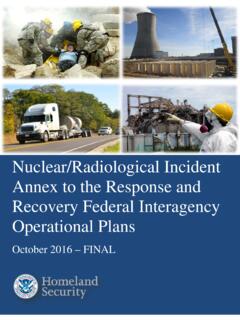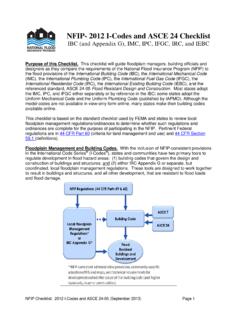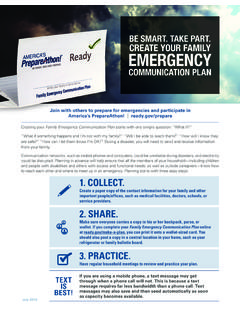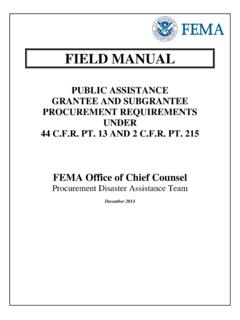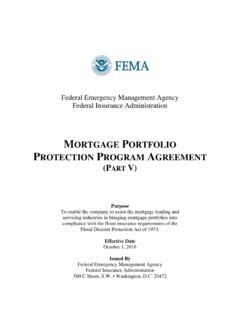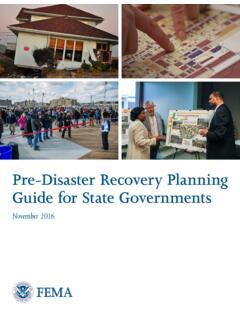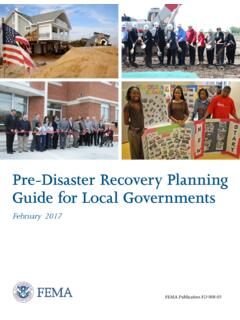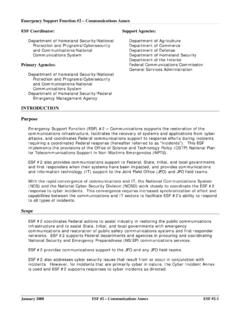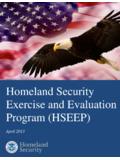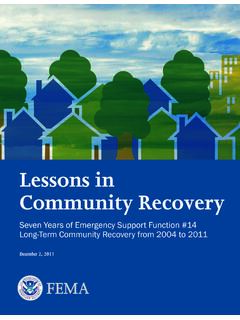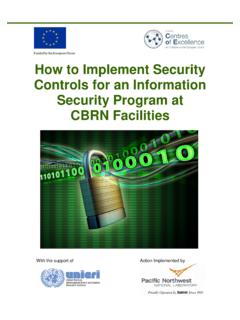Transcription of NATIONAL INCIDENT MANAGEMENT SYSTEM
1 Guideline for the Credentialing of Personnel i August 2011 NATIONAL INCIDENT MANAGEMENT SYSTEM Guideline for the Credentialing of Personnel August 2011 Guideline for the Credentialing of Personnel i August 2011 This page intentionally left blank. Guideline for the Credentialing of Personnel ii August 2011 NIMS GUIDELINE FOR THE .. I CREDENTIALING OF PERSONNEL .. I OVERVIEW .. 1 Purpose .. 1 ApplicAbility .. 1 Intended Audience .. 1 Scope .. 2 NIMS Overview .. 2 Definition of 3 FEMA Administrator s Responsibilities .. 3 SECTION 1 - NATIONAL CREDENTIALING STANDARDS .. 5 General Information .. 5 Expertise and Technical Assistance .. 5 Identification, Qualification, and Typing .. 6 Other Important Activities .. 11 Summary .. 12 SECTION 2 CREDENTIALING OF FEDERAL EMERGENCY response OFFICIALS .. 13 General Guidance .. 13 Identification .. 13 Qualifications .. 13 Deployment Authorization .. 14 Documentation .. 14 NIMS Guideline for the Credentialing of Personnel iii August 2011 SECTION 3 GUIDANCE TO STATE, LOCAL, AND TRIBAL AUTHORITIES AND THE EMERGENCY MANAGEMENT ASSISTANCE COMPACT.
2 15 General Guidance .. 15 APPLICABILITY .. 15 Identification .. 15 Qualifications .. 15 Certification .. 16 Badging .. 16 Other Important Activities .. 16 NIMS-Related Activity Guidance .. 16 SECTION 4 MODEL STANDARDS AND GUIDANCE FOR PRIVATE SECTOR ORGANIZATIONS AND CRITICAL INFRASTRUCTURE OWNERS AND OPERATORS .. 19 General Guidance .. 19 APPLICABILITY .. 19 Identification .. 19 Qualifications .. 20 Certification .. 20 Badging .. 20 Other Important Activities .. 20 SECTION 5 RECOMMENDATIONS FOR NONGOVERNMENTAL ORGANIZATIONS .. 23 General Guidance .. 23 ApplicAbility .. 23 Identification .. 23 Qualifications .. 23 Certification .. 24 NIMS Guideline for the Credentialing of Personnel iv August 2011 Badging .. 24 Other Important Activities .. 24 GLOSSARY OF TERMS AND DEFINITIONS .. 27 STATUTES .. 28 POINTS OF CONTACT .. 28 NIMS Guideline for the Credentialing of Personnel v August 2011 This page intentionally left blank. 1 August 2011 OVERVIEW PURPOSE The Department of Homeland Security (DHS)/Federal Emergency MANAGEMENT Agency (FEMA) developed the NATIONAL INCIDENT MANAGEMENT SYSTEM (NIMS) Guideline for the Credentialing of Personnel (the guideline) to describe NATIONAL credentialing standards and to provide written guidance regarding the use of those standards.
3 This document describes credentialing and typing processes and identifies tools which Federal Emergency response Officials (FERO) and emergency managers at all levels of government may use both routinely and to facilitate multijurisdictional coordinated responses. Through this guideline, DHS/FEMA encourages interoperability among Federal, State, local, territorial, tribal, and private sector officials in order to facilitate emergency responder deployment for response , recovery, and restoration. This guideline also provides information about where emergency response leaders can obtain expertise and technical assistance in using the NATIONAL standards or in ways they can adapt the standards to department, agency, jurisdiction, or organization needs. APPLICABILITY Each Federal agency with responsibilities under the NATIONAL response framework is required to ensure that INCIDENT MANAGEMENT personnel, emergency response providers, and other personnel (including temporary personnel) and resources likely needed to respond to a natural disaster, act of terrorism, or other manmade disaster are credentialed and typed in accordance with 6 320.
4 In addition, Homeland Security Presidential Directive 5 (HSPD -5), MANAGEMENT of Domestic Incidents, requires that the heads of Federal departments and agencies adopt the NATIONAL INCIDENT MANAGEMENT SYSTEM . DHS interprets these authorities to require agencies to ensure that their personnel are credentialed and typed according to these guidelines. Federal Legislative and Judicial Branches, State, local, tribal, private sector partners, and non-governmental organizations (NGO) are not required to credential their personnel in accordance with these guidelines. These non-Federal entities do not need to comply with the Federal Information Processing Standards (FIPS) 201, an open technical standard used by Federal officials for uniform credentialing and access control or other Federal identification requirements for emergency response purposes. However, DHS/FEMA strongly encourages them to do so, in order to leverage the Federal investment in the FIPS 201 infrastructure and facilitating interoperability for personnel deployed outside their home jurisdiction.
5 INTENDED AUDIENCE This document, developed and maintained by DHS/FEMA, is written for government executives; emergency MANAGEMENT practitioners; private-sector, volunteer, and NGO leaders; and critical infrastructure (CI) owners and operators. It is addressed to senior elected and appointed leaders, such as Federal department and/or agency heads, State governors, mayors, tribal leaders, and city 2 August 2011 and/or county officials who have a responsibility to provide effective response . It also is intended for use by private-sector entities entering an impacted area to carry out their own response and recovery activities within the INCIDENT Command SYSTEM (ICS). For these users, this guideline is augmented with online access to supporting documents, further training, and an evolving resource for exchanging lessons learned. SCOPE This guideline applies to incidents such as large-scale terrorist attacks or catastrophic natural disasters where mutual aid and multijurisdictional aid is required.
6 It can be useful for international cross-border initiatives undertaken by States and tribes. NIMS OVERVIEW Mandated by Homeland Security Presidential Directive 5 (HSPD-5), MANAGEMENT of Domestic Incidents, and as outlined in the NATIONAL INCIDENT MANAGEMENT SYSTEM (NIMS) FEMA P-501, NIMS provides a consistent nationwide template to enable Federal, State, tribal, and local governments, NGOs, and the private sector to work together to prevent, protect against, respond to, recover from, and mitigate the effects of incidents, regardless of cause, size, location, or complexity. NIMS represents a core set of doctrines, concepts, principles, terminology, and organizational processes that enables effective, efficient, and collaborative INCIDENT MANAGEMENT . This consistency provides the foundation for utilization of NIMS for all incidents, ranging from daily occurrences to incidents requiring a coordinated Federal response . The NIMS documents integrate best practices into a comprehensive framework for use by emergency MANAGEMENT and response personnel in an all-hazards context nationwide.
7 HSPD-5 requires all Federal departments and agencies to adopt NIMS and to use it in their individual INCIDENT MANAGEMENT programs and activities, as well as in support of all actions taken to assist State, local, and tribal governments. State, local, and tribal governments are not required to participate in NIMS or adopt these best practices. As applied to non-Federal entities, the NIMS documents contain guidance that is not legally binding. However, in order to participate in NIMS and to be considered NIMS compliant, it is necessary for entities to adhere to the standards, practices, and/or minimum criteria presented in the NIMS guidance documents. It is also important to note that although State, local, and tribal governments and NGOs are not required to adhere to NIMS Guidelines, HSPD-5 requires Federal departments and agencies to make adoption of NIMS by State, local, and tribal governments and NGOs a condition for Federal preparedness assistance through grants, contracts, and other activities.
8 A basic premise of NIMS is that all incidents begin and end locally. The Federal Government supports State, local, and tribal authorities when their resources are overwhelmed or anticipated to be overwhelmed. The intention of the Federal Government in these situations is not to command the response , but rather to support the affected State, local, and tribal authorities. This is most easily achieved when all the entities are participating in a unified SYSTEM of emergency MANAGEMENT and INCIDENT response . NIMS also recognizes the role that NGOs and the private sector have in preparedness and activities to prevent, protect against, respond to, recover from, and mitigate the effects of incidents. To ensure unity of effort, NIMS advocates standards to 3 August 2011 include training, experience, credentialing, validation, and physical and medical fitness. Federal, State, tribal, and local certifying agencies, and professional and private organizations with personnel involved in emergency MANAGEMENT and INCIDENT response , are encouraged to credential those individuals in their respective disciplines or jurisdictions.
9 DEFINITION OF CREDENTIALING As the basis for this document, DHS/FEMA refers to the definition of credentialing provided by the Homeland Security Act of 2002, as amended by the Implementing Recommendations of the 9/11 Commission Act of 2007. This language, codified in 6 United States Code ( ) 311, provides that: The terms credentialed and credentialing mean having provided, or providing, respectively, documentation that identifies personnel and authenticates and verifies the qualifications of such personnel by ensuring that such personnel possess a minimum common level of training, experience, physical and medical fitness, and capability appropriate for a particular FEMA ADMINISTRATOR S RESPONSIBILITIES Per 6 320, the FEMA Administrator is responsible for ensuring the development and implementation of credentialing of emergency response providers. The Administrator shall enter into a memorandum of understanding with the administrators of the Emergency MANAGEMENT Assistance Compact (EMAC), State, local, and tribal governments, and organizations that represent emergency response providers, to collaborate on developing standards for deployment capabilities, including for credentialing and typing of INCIDENT MANAGEMENT personnel, emergency response providers, and other personnel (including temporary personnel) and resources likely needed to respond to natural disasters, acts of terrorism, and other man-made disasters.
10 Section 320 of title 6, , also calls on the Administrator to provide standards and detailed written guidance to: Each Federal agency that has responsibilities under the NATIONAL response Plan1 to aid that agency with credentialing and typing INCIDENT MANAGEMENT personnel, emergency response providers, and other personnel (including temporary personnel) and resources likely needed to respond to a natural disaster, act of terrorism, or other man-made disaster; and State, local, and tribal governments, to aid such governments with credentialing and typing of State, local, and tribal INCIDENT MANAGEMENT personnel, emergency response 1 The NATIONAL response framework superseded the NATIONAL response Plan. 4 August 2011 providers, and other personnel (including temporary personnel) and resources likely needed to respond to a natural disaster, act of terrorism, or other man-made disaster. In addition, 6 320 requires the FEMA Administrator to provide expertise and technical assistance to: aid Federal, State, local, and tribal government agencies with credentialing and typing INCIDENT MANAGEMENT personnel, emergency response providers, and other personnel (including temporary personnel) and resources likely needed to respond to a natural disaster, act of terrorism, or other man-made disaster.
